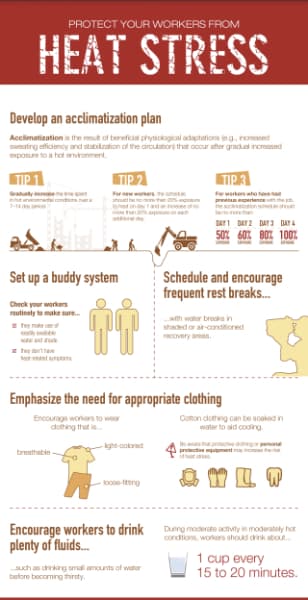3 Ways To Protect Your Workers From Heat Stress
Heat related illness is preventable. Taking appropriate measure to avoid heat stress is the first defence. We have put together some things to do to prevent heat stress for your team. One of the first things you can do to protect workers from heat stress is learn about acclimatization. What is acclimatization?

Acclimatization
 Acclimatization is the result of beneficial physiological adaptations (e.g., increased sweating efficiency and stabilization of the circulation) that occur after gradual increased exposure to a hot environment. [learn more]
Acclimatization is the result of beneficial physiological adaptations (e.g., increased sweating efficiency and stabilization of the circulation) that occur after gradual increased exposure to a hot environment. [learn more]
3 Tips To Develop An Acclimation Plan
Tip 1
Gradually increase exposure time in hot environmental conditions over a 7–14 day period.
Tip 2
For new workers on the jobsite, the schedule should be no more than 20% exposure to heat on day 1 and an increase of no more than 20% exposure on each additional day.
Tip 3
For workers who had previous experience with the job, the acclimatization schedule should be no more than:
- 50% exposure on day 1
- 60% exposure on day 2
- 80% exposure on day 3
- 100% exposure on day 4
Set up a buddy system
Check your workers routinely making sure they have water and shade. Making sure they are not showing any heat related symptoms.
Encourage workers to drink plenty of water
Drinking at least 1 cup of water every 15 minutes before becoming thirsty during moderate work.
 Schedule and encourage frequent rest breaks
Schedule and encourage frequent rest breaks
Make sure breaks are in shade or an air conditioned recovery area with plenty of water.Emphasize the need for proper clothing
- Encourage workers to wear clothing that is breathable, light-colored, and loose-fitting.
- Cotton clothing can be soaked in water to aid cooling.
- Be aware that protective clothing or PPE (personal protective equipment) may increase the risk of heat stress.
PPE with heat stress protection
There are several types of PPE that offer protection from heat. Vests that feature phase change or evaporative technology can reduce heat stress. We have included a little bit about his new technology below.
Phase Change Technology
Vests that feature Phase Change Technology use a phase change pack to cool down the wearer. Here is how it works...
- First, cold temperature is absorbed by the phase change material, changing it from a clear liquid to an opaque solid as it is activated.
- Next, the activated phase change pack is placed into the vest and worn against the body. The cold temperature is transferred to the wearer as the latent heat is absorbed by the phase change material.
Evaporative Technology
Cooling Vests use Evaporative Technology, where water is absorbed by the product’s cooling fibers, and cooling occurs as the moisture within the unit evaporates.
- To facilitate cooling, the vests are worn over other garments, exposed to moving air.
- The vest fabric ensures a uniform cooling effect while staying lightweight and easy to use.
Other wearables, including hats, bandanas, neck shades, neck gaiters and sleeves are also available with evaporative cooling.
To learn more about acclimation to avoid heat stress [learn more]








